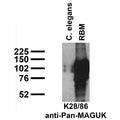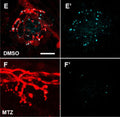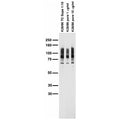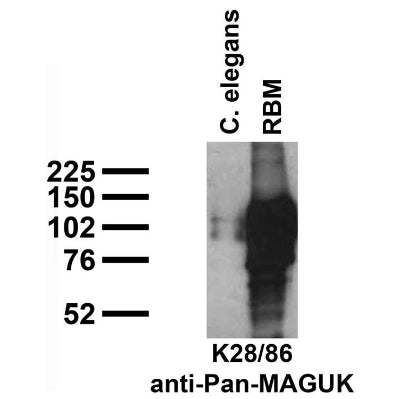Ships: 1-2 business days
Product Specific References for Applications and Species
- Flow Cytometry: Human
- Immunocytochemistry: Human | Mouse | Rat
- Immunohistochemistry: Chicken | Drosophila | Mouse | Zebrafish
- Scanning electron microscopy: Trichoplax
- Western Blot: Mouse | Rat | Zebrafish
| Flow Cytometry: Human | ||
| PMID | Dilution | Publication |
| 36661138 | 1:500 | Chann, A.S., et al. 2023. Scribble and E-cadherin Cooperate to Control Symmetric Daughter Cell Positioning by Multiple Mechanisms. Journal of Cell Science, jcs260547. |
| Immunocytochemistry: Human | ||
| PMID | Dilution | Publication |
| 27120160 | 1:100 | Paquet, D., et al. 2016. Efficient introduction of specific homozygous and heterozygous mutations using CRISPR/Cas9. Nature , 125-129. |
| Immunocytochemistry: Mouse | ||
| PMID | Dilution | Publication |
| 28380365 | 1:500 | Lehigh, K.M., et al. 2017. Retrogradely Transported TrkA Endosomes Signal Locally within Dendrites to Maintain Sympathetic Neuron Synapses. Cell Reports, 86-100. |
| 26575286 | 1:1000 | Martin, E.A., et al. 2015. The intellectual disability gene Kirrel3 regulates target-specific mossy fiber synapse development in the hippocampus. Elife, e09395. |
| Immunocytochemistry: Rat | ||
| PMID | Dilution | Publication |
| 27107637 | 1:500 | Abiraman, K., et al. 2016. Tonic PKA Activity Regulates SK Channel Nanoclustering and Somatodendritic Distribution. Journal of Molecular Biology, 2521-2537. |
| 21525273 | 1:500 | Chen, X., et al. 2011. PSD-95 is required to sustain the molecular organization of the postsynaptic density. Journal of Neuroscience, 31(17), pp.6329-6338.. Journal of Neuroscience, 6329-6338. |
| 18986540 | 1:500 | Davis, E.K., et al. 2008. Wnts acting through canonical and noncanonical signaling pathways exert opposite effects on hippocampal synapse formation. Neural Development, 32. |
| Immunohistochemistry: Chicken | ||
| PMID | Dilution | Publication |
| 30377270 | 1:100 | Li, Y., et al. 2018. Discs large 1 controls daughter-cell polarity after cytokinesis in vertebrate morphogenesis. PNAS: USA, E10859-E10868. |
| Immunohistochemistry: Drosophila | ||
| PMID | Dilution | Publication |
| 39133541 | 1:500 | Dasgupta, A, et al. 2024. Semaphorin7A patterns neural circuitry in the lateral line of the zebrafish. eLife, . |
| Immunohistochemistry: Mouse | ||
| PMID | Dilution | Publication |
| 38360747 | not listed | Delhaye, M, et al. 2024. Adaptation of Magnified Analysis of the Proteome for Excitatory Synaptic Proteins in Varied Samples and Evaluation of Cell Type-Specific Distributions. The Journal of neuroscience : the official journal of the Society for Neuroscience, . |
| 30687002 | not listed | Yamagata, M., et al. 2019. Expression and roles of the immunoglobulin superfamily recognition molecule sidekick1 in mouse retina. Frontiers in molecular neuroscience, 11, p.485.. Frontiers in molecular neuroscience, 485. |
| 26287463 | not listed | Krishnaswamy, A., et al. 2015. Sidekick 2 directs formation of a retinal circuit that detects differential motion. Nature, 466-470. |
| 25224259 | 1:100 | Bergeron, S.A., et al. 2015. Gsx1 expression defines neurons required for prepulse inhibition.. Molecular Psychiatry, 974-985. |
| 20696380 | 2ug/ml | Sharma, N., et al. 2010. Long-distance control of synapse assembly by target-derived NGF. Neuron, 422-434. |
| 20634890 | 1:100 | Li, L., et al. 2010. Visualizing the distribution of synapses from individual neurons in the mouse brain. PLoS One, e11503. |
| Immunohistochemistry: Zebrafish | ||
| PMID | Dilution | Publication |
| 39381501 | 1:200 | Lee, DW, et al. 2024. Transgenic zebrafish as a model for investigating diabetic peripheral neuropathy: investigation of the role of insulin signaling. Frontiers in Cellular Neuroscience, 1441827. |
| 38294129 | 1:200 | Lee, DW, et al. 2024. Protective effect of alpha-lipoic acid and epalrestat on oxaliplatin-induced peripheral neuropathy in zebrafish. Muscle & nerve, 498-503. |
| 36261670 | 1:500 | Saettele, A.L., et al. 2022. Prolonged dexamethasone exposure enhances zebrafish lateral-line regeneration but disrupts mitochondrial homeostasis and hair cell function. Journal of the Association of Research in Otolaryngology, 683-700. |
| 34665127 | 1:500 | Holmgren, M., et al. 2021. Mechanical overstimulation causes acute injury and synapse loss followed by fast recovery in lateral-line neuromasts of larval zebrafish. Elife, e69264. |
| 34413725 | 1:500 | Holmgren, M., et al. 2021. Influence of Mpv17 on hair-cell mitochondrial homeostasis, synapse integrity, and vulnerability to damage in the zebrafish lateral line. Frontiers in Cellular Neuroscience, 693375. |
| 33958989 | 1:500 | Colón-Cruz, L., et al. 2021. Cnr2 Is Important for Ribbon Synapse Maturation and Function in Hair Cells and Photoreceptors. Frontiers in Molecular Neuroscience, 624265. |
| 33361086 | 1:250 | Koleilat, A., et al. 2020. L-type voltage-gated calcium channel agonists mitigate hearing loss and modify ribbon synapse morphology in the zebrafish model of Usher syndrome type 1. Disease models and Mechanisms, . |
| 31609202 | 1:500 | Wong, H.T.C., et al. 2019. Synaptic mitochondria regulate hair-cell synapse size and function. Elife, e48914. |
| 31582816 | 1:500 | Manchanda, A., et al. 2019. Otoferlin Depletion Results in Abnormal Synaptic Ribbons and Altered Intracellular Calcium Levels in Zebrafish. Scientific Reports, 14273. |
| 30286167 | 1:100 | Fierro Jr, J., et al. 2018. 4.1Ba is necessary for glutamatergic synapse formation in the sensorimotor circuit of developing zebrafish. PLoS One, e0205255. |
| 30225343 | 1:500 | Uribe, P.M., et al. 2018. Larval Zebrafish Lateral Line as a Model for Acoustic Trauma. eNeuro, . |
| 29739870 | 1:100 | Miller, A.H., et al. 2018. Pregnancy-Associated Plasma Protein-aa Regulates Photoreceptor Synaptic Development to Mediate Visually Guided Behavior. Journal of Neuroscience, 5220-5236. |
| 29671737 | 1:500 | Ji, Y.R., et al. 2018. Directional selectivity of afferent neurons in zebrafish neuromasts is regulated by Emx2 in presynaptic hair cells. Elife, e35796. |
| 29643351 | 1:500 | Zhang, Q., et al. 2018. Synaptically silent sensory hair cells in zebrafish are recruited after damage. Nature Communications, 1388. |
| 28546313 | 1:500 | Sheets, L., et al. 2017. Enlargement of Ribbons in Zebrafish Hair Cells Increases Calcium Currents But Disrupts Afferent Spontaneous Activity and Timing of Stimulus Onset. Journal of Neuroscience, 6299-6313. |
| 28112265 | 1:500 | Sheets, L., et al. 2017. Excessive activation of ionotropic glutamate receptors induces apoptotic hair-cell death independent of afferent and efferent innervation. Scientific Reports, 41102. |
| 27425195 | 1:500 | Pei, W., et al. 2016. Additive reductions in zebrafish PRPS1 activity result in a spectrum of deficiencies modeling several human PRPS1-associated diseases. Scientific Reports, 29946. |
| 26180195 | not listed | Gopal, S.R., et al. 2015. Zebrafish Models for the Mechanosensory Hair Cell Dysfunction in Usher Syndrome 3 Reveal That Clarin-1 Is an Essential Hair Bundle Protein. Journal of Neuroscience, 10188-10201. |
| 25995190 | 1:500 | Dow, E., et al. 2015. Cellular projections from sensory hair cells form polarity-specific scaffolds during synaptogenesis. Genes Development, 1087-1094. |
| 25208216 | 1:500 | Sheets, L., et al. 2014. Characterization of Ribeye subunits in zebrafish hair cells reveals that exogenous Ribeye B-domain and CtBP1 localize to the basal ends of synaptic ribbons. PLoS One, e107256. |
| 23416047 | 1:100 | Randlett, O., et al. 2013. Cellular requirements for building a retinal neuropil. Cell Reports, 282-290. |
| 23197719 | not listed | Sheets, L., et al. 2012. Presynaptic CaV1.3 channels regulate synaptic ribbon size and are required for synaptic maintenance in sensory hair cells. Journal of Neuroscience, 17273-17286. |
| 21350006 | not listed | Sheets, L., et al. 2011. Ribeye is required for presynaptic Ca(V)1.3a channel localization and afferent innervation of sensory hair cells. Development, 1309-1319. |
| Scanning Electron Microscopy: Trichoplax | ||
| PMID | Dilution | Publication |
| 24954051 | not listed | Smith, C.L., et al. 2014. Novel cell types, neurosecretory cells, and body plan of the early-diverging metazoan Trichoplax adhaerens. Current Biology, 1565-1572. |
| Western Blot: Mouse | ||
| PMID | Dilution | Publication |
| 27677249 | not listed | Isoo, N., et al. 2016. The decline in synaptic GluN2B and rise in inhibitory neurotransmission determine the end of a critical period. Scientific Reports, 34196. |
| 26005851 | 1:1000 | Shin, S., et al. 2015. mGluR5 in the nucleus accumbens is critical for promoting resilience to chronic stress. Nature Neuroscience, 1017-1024. |
| 21880917 | not listed | Kiraly, D.D., et al. 2011. Kalirin binds the NR2B subunit of the NMDA receptor, altering its synaptic localization and function. Journal of Neuroscience, 12554-12565. |
| Western Blot: Rat | ||
| PMID | Dilution | Publication |
| 30667360 | 1:5 (supe) | Andrews, N.P., et al. 2019. A toolbox of IgG subclass-switched recombinant monoclonal antibodies for enhanced multiplex immunolabeling of brain. Elife, e43322. |
| 23486974 | not listed | Murata, Y., et al. 2013. Postsynaptic density scaffold SAP102 regulates cortical synapse development through EphB and PAK signaling pathway. Journal of Neuroscience, 5040-5052. |
| Western Blot: Zebrafish | ||
| PMID | Dilution | Publication |
| 35346959 | 1:1000 | Tallafuss, A., et al. 2022. Egr1 Is Necessary for Forebrain Dopaminergic Signaling during Social Behavior. eNeuro, . |




![Immunoblot against crude membrane fractions from whole mouse (MBM) or rat (RBM) brain and from human cerebellum [HBM(Cb)], cerebral cortex [HBM(Cx)] or hippocampus [HBM(H)] probed with K28/86 (left) or N52A/42 (right) TC supe.](http://www.antibodiesinc.com/cdn/shop/files/73-029-k28-86-wb-3_120x120.jpg?v=1743796747)


